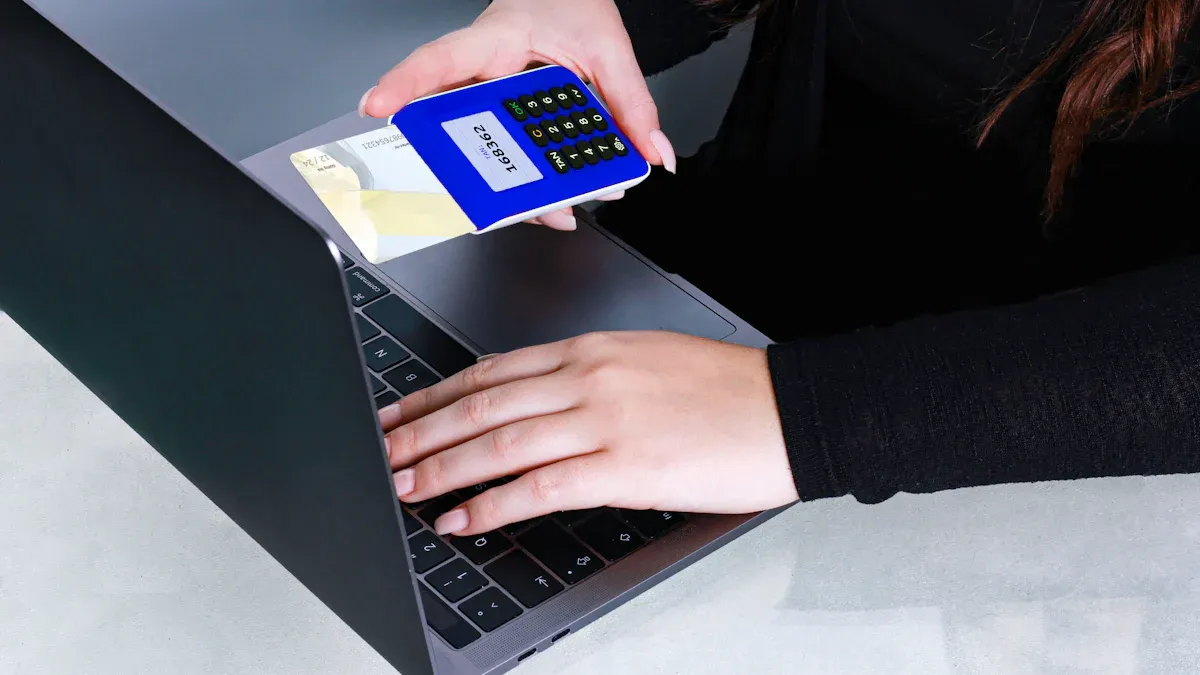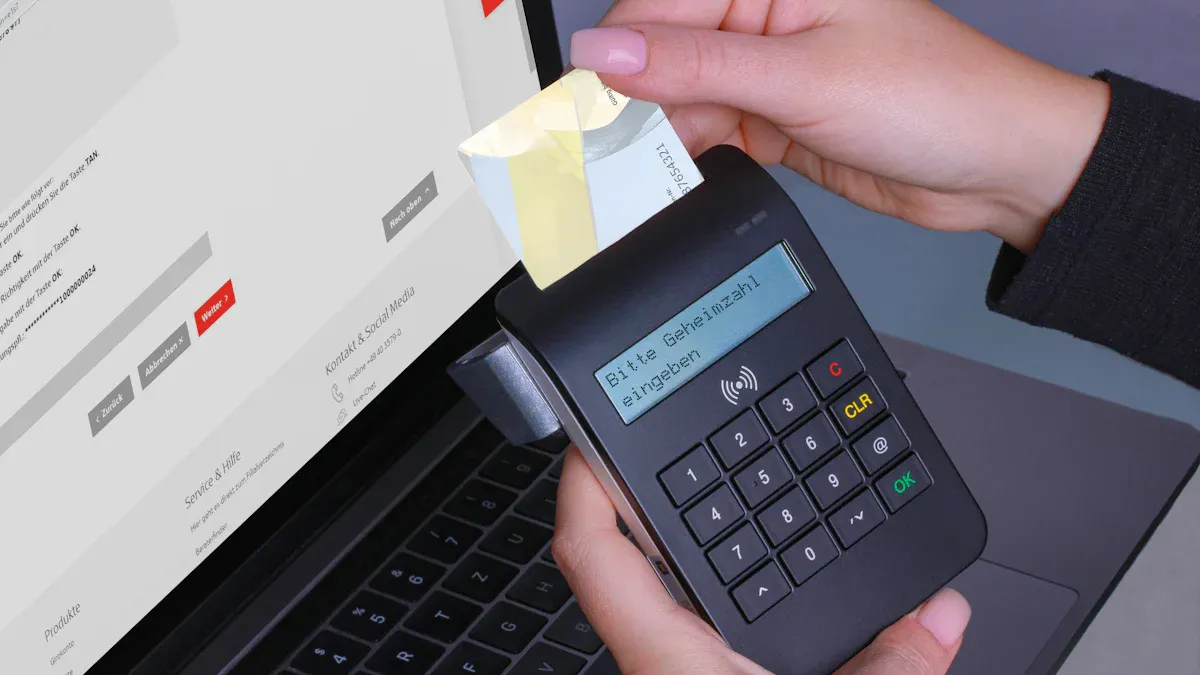- EasyCard
- Trade
- Help
- Announcement
- Academy
- SWIFT Code
- Iban Number
- Referral
- Customer Service
- Blog
- Creator
Cross-Border E-Commerce Payment Security Guide: Ensuring Every Order's Funds Arrive Safely

Image Source: pexels
When reconciling accounts late at night, have you ever discovered abnormal order funds or suddenly received a cold chargeback notice? This is the dilemma faced by many sellers.
Visible orders, uncollectible money.
Ensuring cross-border trade payment security and allowing profits from every transaction to be safely pocketed is your core demand. This article provides you with a set of feasible risk response strategies to help you proactively defend against fund risks instead of passively remedying after losses occur.
Key Points
- Before the transaction, selecting appropriate payment methods and signing detailed contracts can effectively prevent fund risks.
- Identifying high-risk orders and setting payment gateway risk control rules can help you intercept fraudulent behavior.
- During the transaction, properly handling credit card chargeback appeals and retaining complete transaction evidence can protect your profits.
- Regularly monitoring the health of payment accounts and understanding the reasons for platform fund freezes can avoid unnecessary losses.
- After the transaction, using multi-factor authentication to protect accounts, selecting compliant settlement channels, and managing exchange rate fluctuations can ensure funds arrive safely.
Pre-Transaction Prevention: Building the First Line of Defense for Fund Security

Image Source: unsplash
The best strategy for fund security is proactive prevention rather than passive remedy. Before the buyer clicks “pay,” you can already deploy multiple lines of defense to nip potential risks in the bud. This first step determines the overall security level of subsequent transactions.
Strategic Selection of Payment Methods
Choosing the right payment method is the first step in ensuring cross-border trade payment security. Different payment tools vary in convenience, cost, and risk level. You need to make strategic combinations based on your target market, average order value, and business model.
- Online Payment vs. Traditional Trade Payment
For most cross-border e-commerce sellers, especially B2C and small B2B businesses, online payment is mainstream. But understanding the pros and cons of traditional methods can help you make better choices when facing large or special orders.
| Payment Category | Specific Methods | Advantages | Disadvantages | Applicable Scenarios |
|---|---|---|---|---|
| Online Payment | Credit cards, PayPal, and other e-wallets | Fast payment process, good user experience, wide coverage | Higher transaction fees, chargeback risk | B2C retail, small B2B orders |
| Traditional Payment | Telegraphic Transfer (T/T) | Low risk for sellers (especially with advance payment), no chargebacks | High trust cost for buyers, slow fund arrival, not suitable for small transactions | Large B2B orders, customized production |
| Letter of Credit (L/C) | Bank credit endorsement, high security | Complex procedures, high bank fees, extremely strict document requirements | Huge international trade | |
| Collection | Simpler operation than L/C, lower fees | Pure commercial credit, bank does not bear payment responsibility, higher risk | Long-term cooperation, reputable old customers |
Special Tip: Beware of D/A Risks in Collection Collection is divided into two types:
- Documents against Payment (D/P): The buyer must pay in full to obtain shipping documents for pickup. For you, the risk is relatively small.
- Documents against Acceptance (D/A): The buyer only needs to promise payment on a future date (time draft) to obtain documents for pickup. This means you face the risk of the buyer not paying on maturity, losing both goods and payment. Unless you have a long-term and extremely trusting relationship with the other party, strongly avoid using D/A.
- Insight into Regional Payment Preferences
Catering to local consumers’ payment habits not only boosts conversion rates but also allows you to better assess risks. The global payment market landscape varies greatly, with e-wallets dominating, but regional characteristics remain distinct.
2023 Major E-Commerce Markets Payment Method Shares
| Region | Payment Method | Market Share (2023) |
|---|---|---|
| North America | Bank Cards | 53% |
| E-Wallets | 30% | |
| Europe | Bank Cards | 43% |
| E-Wallets | 29% | |
| Bank Transfers | 24% | |
| Asia-Pacific | E-Wallets | 70% |
For example, in North America and Europe, credit card payments remain the cornerstone; in the Asia-Pacific market, not offering mainstream e-wallets makes it almost impossible to operate.
Signing Rigorous Transaction Contract Terms
For B2B transactions, a sales contract with clear rights and responsibilities is your talisman. Do not neglect this step because the order amount is small or communication with the customer seems smooth. Ambiguous terms are breeding grounds for future disputes. The case of Amazon and the U.S. Federal Trade Commission (FTC) once led to expensive litigation due to vague refund terms, warning us that unclear terms can directly cause financial losses.
Your contract should include at least the following key terms:
- Clear Payment Terms
Payment Currency: Clearly specify which currency to use for settlement, recommending stable international mainstream currencies like USD.Payment Method: List the payment methods accepted by both parties and related account information.Payment Timeline: Clearly define the advance payment ratio, balance payment nodes, or specific deadlines for full payment.Fee Allocation: Clearly state which party bears bank handling fees, transfer fees.- Clear Dispute Resolution Terms
Governing Law: Agree on which country or region’s law applies for interpretation and adjudication in case of disputes.Jurisdiction: Clearly specify which local court or arbitration institution will hear the case.Resolution Mechanism: Prioritize agreeing to resolve disputes through neutral international arbitration institutions (such as ICC, LCIA), whose awards are usually easier to enforce than cross-border litigation.
Identifying High-Risk Fraudulent Orders
Fraudsters often leave clues when placing orders. You need to act like a detective, learn to identify these danger signals, and intercept fraudulent behavior before shipping.
High-Risk Order Self-Check Checklist:
- Abnormal Order Patterns
Huge Amounts: Order value far exceeds the store’s average order value, such as suddenly appearing thousands of dollars in orders.Abnormal Quantities: Purchasing large quantities of the same high-priced item at once, especially combinations of different sizes or colors.First Order is a Big One: New registered accounts’ first order is high-value goods, without hesitation.- Mismatched Address Information
Billing and Shipping Addresses Do Not Match: This is one of the classic fraud signals; fraudsters use stolen credit card information but ship goods to addresses they control.Multiple Orders Using Different Payment Cards but Shipped to the Same Address: Possibly a fraud ring using a batch of stolen cards to collect goods centrally.Shipping Address is a Freight Forwarder or High-Risk Area: Fraudsters often use forwarding services to hide their real location.- Suspicious Payment and Contact Methods
Successful After Multiple Failed Payments: This is likely “card testing,” attempting to crack stolen credit card information.Using Temporary or Suspicious Emails: Email addresses look like randomly generated strings or use disposable email services.Requesting Expedited Shipping: Fraudsters want to receive goods quickly before the cardholder discovers and reports the card lost, so they are willing to pay extra expedited shipping for high-priced items.
Setting Payment Gateway Risk Control Rules
In addition to manual identification, you must use the technical tools provided by payment gateways to automatically filter risks. This is your automated defense line against programmatic fraud attacks.
- Enable Basic Verification Rules: AVS and CVV
- Address Verification System (AVS): This system checks whether the numeric part of the billing address entered by the buyer matches the issuing bank’s records. It is a basic tool for verifying cardholder identity, very effective mainly in credit card transactions in the US, Canada, and UK.
- Card Verification Value (CVV): The 3- or 4-digit security code on the back of the credit card. Requiring CVV input can effectively prove the payer holds the physical card.
Practical Advice: In your payment gateway backend, be sure to enable CVV verification rules and set to “reject transaction if CVV is not provided.” For AVS, due to varying international support and possible misjudgments, prioritize enabling for orders from the US, UK, Canada, and cautiously set overly strict rejection rules to avoid missing normal orders.
- Embrace Stronger Security Protocols: 3D Secure 2.0 3D Secure (3DS) is a more advanced identity verification protocol. It adds a verification step during payment, requiring the cardholder to confirm identity via SMS code, fingerprint, or facial recognition.
Its biggest advantage is “Liability Shift.
Once a transaction passes 3DS verification, even if later proven fraudulent and resulting in a chargeback, the loss responsibility usually shifts from you (merchant) to the issuing bank. Studies show that enabling 3D Secure can reduce fraud-related chargebacks by up to 70%. It securely shares over 100 data points (such as device information, transaction history) between merchants and issuing banks, allowing banks to assess risks more accurately, greatly enhancing transaction security without sacrificing user experience.
In-Transaction Monitoring: Efficiently Handling Payment Disputes
Transaction completion does not mean funds are safe and sound. From buyer payment to final settlement, intermediate links hide risks like chargebacks and freezes. Establishing a real-time monitoring and response mechanism is key to ensuring cross-border trade payment security.
Properly Handling Credit Card Chargeback Appeals
Credit card chargebacks (Chargeback) are a sword hanging over all cross-border sellers. When receiving a chargeback notice, do not panic or give up directly. Understanding the process and rules, you have every chance to win back the profits that belong to you.
Chargeback Process Overview Chargebacks are not one-step; they are a multi-stage process. Understanding each stage helps you make correct decisions.
- Customer Raises Dispute: Cardholder contacts their issuing bank to question a transaction.
- Bank Provides Provisional Refund: Issuing bank usually first provides a provisional credit to the cardholder while sending a chargeback notice to your acquiring bank.
- Merchant Receives Notice: Your acquiring bank or payment gateway notifies you. At this point, you decide whether to accept the chargeback or appeal.
- Submit Appeal Materials: If you choose to appeal, you must submit a complete set of rebuttal evidence within the specified time (usually 7-21 days), called “Representment.”
- Bank Reviews and Decides: Issuing bank reviews your submitted evidence. If evidence is sufficient, chargeback is reversed, funds returned to you; otherwise, chargeback is upheld, provisional refund becomes permanent loss.
- Enter Arbitration: If dissatisfied with the bank’s decision, you can apply for arbitration with the card network (e.g., Visa, Mastercard). This is the last resort, usually with high fees (up to hundreds of dollars), borne by the losing party.
Understand Chargeback Reasons, Precisely Rebut
Every chargeback has a “reason code” (Reason Code) explaining the customer’s dispute reason. You need to prepare targeted evidence based on this code. Common chargeback reasons fall into four categories:
- Fraudulent Transaction: Cardholder claims they did not authorize the transaction. This is the most common type.
- Customer Dispute: Customer dissatisfied with goods or services, e.g., “did not receive goods,” “goods not as described,” or “canceled subscription.”
- Processing Error: Technical issues during transaction, e.g., duplicate charges, wrong amount.
- Authorization Issue: Problems in authorization, e.g., expired authorization.
The table below shows common reason codes for similar disputes across card networks to help you quickly locate issues:
| Dispute Type | Visa | Mastercard | American Express |
|---|---|---|---|
| Goods/Services Not Received | 13.1 | 4855 | C08 |
| Not as Described/Defective | 13.3 | 4853 | C31 / C32 |
| Canceled Recurring Billing | 13.2 | 4841 | C28 |
| Duplicate Processing/Paid by Other Means | 12.6 | 4834 | P08 |
| Non-Processed Credit | 13.6 | 4860 | C02 |
When receiving a chargeback, the first step is to find the reason code and immediately start collecting rebuttal evidence.
Retaining a Complete Transaction Evidence Chain
In chargeback appeals, evidence is the only standard determining victory or defeat. You must consciously save all related transaction records from the moment the order is generated. A complete evidence chain makes your appeal more convincing.
Depending on the dispute type, the evidence you need to submit varies. Here is a universal core evidence checklist:
- Basic Transaction Information
Order Screenshot: Complete information including goods, amount, order time.Payment Verification Records: AVS (address verification) and CVV (security code) match results.IP Address and Device Information: IP address and device type used by the customer when ordering, to prove consistency with usual addresses.- Logistics and Delivery Proof
Shipping and Tracking Number: Clearly showing the full package trajectory.Proof of Delivery: One of the strongest evidences, preferably with recipient signature. If signature unavailable, attached photo of successful delivery is helpful.- Customer Communication Records
Email Correspondence: All emails with the customer about orders, shipping, product inquiries.Online Chat Records: Screenshots of conversations with the customer on the platform or instant messaging tools.Terms of Service and Policies: Screenshots of refund policies, terms of service pages agreed by the customer when ordering.- Digital Goods and Services Evidence
Software or Service Usage Logs: Proving the customer logged in and used your digital product.Download Records: Showing the customer successfully downloaded files.
Practical Advice:Build Your Digital Archive System Manually organizing evidence is time-consuming. You can use cloud storage (like Google Drive, Dropbox) and automation tools to build an efficient archive system:
- Establish Standard Folder Structure: Create a main folder, e.g., “Transaction Records,” with subfolders by “year-month.”
- Uniform File Naming Rules: Use a uniform format for all files, e.g.,
OrderNumber_CustomerName_FileType.pdf(like10521_JohnDoe_ShippingProof.pdf).- Use Automation Tools: Use tools like Zapier to set automation, e.g., when receiving a new order email, automatically save attachments to the specified cloud folder.
Real-Time Monitoring of Payment Account Health
Payment platforms (like Stripe, PayPal) and e-commerce platforms (like Amazon) closely monitor your account health, with one of the most important metrics being “Chargeback Rate.”
Chargeback rate is usually calculated as: Number of chargebacks received in the month / Total transactions in the month
Once this ratio exceeds the limit, your account faces serious risks.
| Payment Platform | Chargeback Rate Alert Line | Consequences |
|---|---|---|
| Stripe | Above 0.9% considered high | Account review, restricted receipts, even direct closure |
| PayPal | Above 1.5% or over 100 in 3 months | Account functions limited, funds frozen, even permanent ban |
Proactive Monitoring, Prevent Issues Do not wait for platform warning emails to act. You should:
- Weekly Checks: Regularly log into your payment gateway and e-commerce platform backend to view chargeback rate and dispute cases.
- Analyze Reasons: If chargeback rate rises, immediately analyze reason codes to find if fraud increased or product descriptions unclear.
- Optimize Front-End: Based on analysis, return to “pre-transaction prevention” to optimize risk control rules, product pages, or customer service processes.
Handling Platform Transaction Reviews and Fund Freezes
“Your account funds have been temporarily frozen”—this may be the notification every cross-border seller least wants to receive. Fund freezes are usually triggered automatically by the platform’s risk system for various reasons.
Common Fund Freeze Triggers:
- Account Information Issues: Tax information, company documents, or legal person identity verification expired or incomplete.
- Abnormal Sales Behavior:
- Sales suddenly skyrocket in a short period.
- Return rate or negative review rate significantly increases.
- Suddenly starting to sell high-risk or high-value goods.
- Platform Policy Violations:
- Complained for selling counterfeit or intellectual property infringing (trademark, copyright) goods.
- Selling platform-prohibited goods.
- High-Risk Transactions: Receiving many orders from high-risk regions or sudden chargeback rate increase.
How to Handle Fund Freezes?
- Stay Calm, Carefully Read the Notice: Platform notification emails usually explain the freeze reason and required materials.
- Act Immediately: Submit all required documents as soon as possible. If information incomplete, update immediately; if performance issues, prepare a detailed action plan (Plan of Action - POA) explaining causes and improvement measures.
- Communicate Professionally and Sincerely: When communicating with the platform, stay professional and honest. Acknowledge issues (if they exist) and clearly show your determination and specific steps to resolve. Do not use templated responses; address specific issues.
- Retain All Communication Records: Save all emails and Case records with the platform for future appeals.
Proactively managing in-transaction risks allows you to take the initiative when facing payment disputes, maximizing protection of your hard work.
Post-Transaction Management: Ensuring Compliant Fund Receipt

Image Source: pexels
Funds entering the platform account is just the first step; how to safely, compliantly, and low-cost transfer them back to your bank account is the last mile in securing profits. Management at this stage directly determines your final earnings.
Multi-Platform Fund Account Security Strategies
You manage fund accounts across multiple platforms, each a potential risk point. According to reports, up to 74% of data breaches involve human factors, so strengthening account security is crucial.
Core Security Principles:
- Enable Multi-Factor Authentication (MFA): This is your account’s “double insurance.” Even if the password leaks, attackers cannot log in with just the password. Enabling MFA is a mandatory requirement to meet PCI-DSS and other compliance standards, effectively protecting your payment gateway.
- Apply Principle of Least Privilege (PoLP): Assign role-based permissions to team members . Customer service does not need financial permissions, operations do not need admin permissions. Regularly review and remove unnecessary account access.
- Enforce Strong Password Policy: Require passwords at least 12 characters, including letters, numbers, and special characters.
Selecting Compliant and Efficient Settlement Channels
Choosing the right settlement service provider is key to ensuring compliant fund receipt. You need to evaluate the following core criteria:
- Regulation and Compliance: The provider must hold compliant licenses, e.g., regulated by UK FCA or US FinCEN. This helps share your KYC (Know Your Customer) and AML (Anti-Money Laundering) compliance burdens.
- Data Transparency: Fees, exchange rates, processing times should be clear, no hidden costs.
- Settlement Speed: Fast arrival improves fund liquidity and reduces exchange rate fluctuation risks.
Global payment providers like Payoneer or WorldFirst usually have bank-level security systems and offer compliant fund settlement solutions worldwide.
Managing Exchange Rate Fluctuation Risks
Small exchange rate fluctuations can erode your hard-earned profits. You can take proactive measures to manage this risk.
- Prefer Stable Currency Settlement: Agree in contracts to use mainstream stable currencies like USD for settlement, the most direct hedging method.
- Use Currency Baskets: If your business involves multiple currencies, consider basket of currencies for settlement instead of relying on a single foreign currency. Studies show basket-based settlement is more stable than single currency.
- Use Hedging Tools: For future confirmed large receipts, use Forward Contracts through banks or payment providers to lock in a future exchange rate in advance.
Preventing New Account Phishing Scams
Fraudsters are using increasingly realistic phishing emails to steal your account credentials. Business Email Compromise (BEC) scams once cost Google and Facebook over 100 million USD. You must learn to identify these danger signals.
Beware of These Phishing Email Characteristics:
- Suspicious Sender: Email address has subtle differences from official domain (e.g.,
support@micros0ft.com). - Urgent or Threatening Language: Email claims your account “will be suspended,” urging you to “immediately” click the link.
- Generic Greetings: Uses “Dear Customer” instead of your name.
- Obvious Grammar Errors: Official emails from professional companies rarely have low-level spelling or grammar mistakes.
When receiving any suspicious email asking for your password or to click links, do not operate directly. This concerns your cross-border trade payment security.
Systematized Improvement: Building a Long-Term Cross-Border Trade Payment Security Mechanism
Single-point defenses are easily bypassed; you need a systematized security mechanism. This not only resists current risks but adapts to future evolving threats, making fund security a solid backing for your business growth.
Establishing Internal Fund Security Verification Processes
Fund security is not one person’s job but the whole team’s responsibility. You need a clear, executable internal verification process to integrate security awareness into daily work.
Core Principle: Trust, but verify.
You can set a simple daily or weekly reconciliation checklist, assigning dedicated personnel for cross-verification:
- Order and Receipt Matching: Verify platform order amounts match actual receipts in the payment gateway.
- Refund and Chargeback Records: Review all refund and chargeback applications, ensuring each has clear reasons and processing records.
- Platform Fee Calculation: Check platform transaction fees, advertising fees, etc., for accuracy.
Using Technical Tools to Improve Risk Control Efficiency
When order volume grows, manual review alone cannot handle massive fraud risks. You need professional technical tools for automated, intelligent risk control. These tools greatly enhance your efficiency and accuracy.
Many mature fraud detection solutions on the market use AI and machine learning to provide powerful protection:
- Automated Decisions: Tools like Riskified and Signifyd analyze each transaction in real-time and directly give “approve” or “reject” suggestions, freeing you from guessing.
- Multi-Dimensional Verification: Tools like FraudLabs Pro offer over 40 verification rules, from IP address, proxy detection to transaction velocity, comprehensively scanning suspicious behavior.
- Behavioral Pattern Analysis: These tools identify and flag abnormal shopping patterns, e.g., new accounts suddenly placing high-value orders, effectively intercepting potential fraud.
Regular Security Training and Knowledge Updates
Technology is the shield, people are the shield bearers. Employee security awareness is the most important link in the entire cross-border trade payment security system. Regular training ensures your team stays vigilant.
Your security training should cover at least the following core contents:
- Payment Card Industry Data Security Standard (PCI-DSS): Let the team understand basic rules for handling credit card information.
- Data Privacy Regulations: Familiarize with mainstream regulations like GDPR, know how to responsibly handle customer personal data.
- Identifying Phishing Attacks: Train employees to recognize and report suspicious phishing emails and messages.
At the same time, stay updated on industry dynamics. Regularly read J.P. Morgan payment insights or professional fintech media reports like bobsguide to understand the latest payment fraud methods and defense strategies, timely updating your security knowledge base.
Cross-border trade payment security is a systematic project throughout the transaction. Proactive defense far surpasses passive remedy. Now, conduct a comprehensive “check-up” on your settlement process.
Fund Security Action Checklist
- Review existing payment method combinations.
- Update payment gateway risk control rules.
- Establish complete transaction evidence retention processes.
- Check security settings for all platform accounts.
Build a perfect security system, and you can focus on business growth, achieving worry-free global expansion.
FAQ
How to balance strict risk control rules with user experience?
You can adopt dynamic risk control strategies. Enable 3D Secure verification for high-risk orders (e.g., large amounts, new customers). For low-risk or returning customers, appropriately relax rules to ensure smooth payment processes, optimizing conversion rates.
After receiving a credit card chargeback notice, what is the first step?
Core Action: Analyze the reason, prepare evidence.
Stay calm, do not accept immediately. First, check the chargeback reason code (Reason Code) to understand the specific dispute reason. Then, immediately start collecting all related transaction and logistics evidence based on the code type to prepare for appeal.
How to proactively prevent platform fund freezes?
Regularly update account business and tax information to ensure validity. Maintain stable account performance, avoid sudden spikes in chargeback or return rates. If anticipating major promotions, communicate in advance with your platform account manager.
After failing a chargeback appeal, is it worth applying for arbitration?
Arbitration is the last resort. Evaluate the involved amount against arbitration costs. Arbitration fees can reach hundreds of dollars, borne by the loser. If the order amount is small, abandoning appeal and focusing on optimizing front-end risk control may be more economical.
*This article is provided for general information purposes and does not constitute legal, tax or other professional advice from BiyaPay or its subsidiaries and its affiliates, and it is not intended as a substitute for obtaining advice from a financial advisor or any other professional.
We make no representations, warranties or warranties, express or implied, as to the accuracy, completeness or timeliness of the contents of this publication.




Contact Us
Company and Team
BiyaPay Products
Customer Services
BIYA GLOBAL LLC is a licensed entity registered with the U.S. Securities and Exchange Commission (SEC No.: 802-127417); a certified member of the Financial Industry Regulatory Authority (FINRA) (Central Registration Depository CRD No.: 325027); regulated by the Financial Industry Regulatory Authority (FINRA) and the U.S. Securities and Exchange Commission (SEC).
BIYA GLOBAL LLC is registered with the Financial Crimes Enforcement Network (FinCEN), an agency under the U.S. Department of the Treasury, as a Money Services Business (MSB), with registration number 31000218637349, and regulated by the Financial Crimes Enforcement Network (FinCEN).
BIYA GLOBAL LIMITED is a registered Financial Service Provider (FSP) in New Zealand, with registration number FSP1007221, and is also a registered member of the Financial Services Complaints Limited (FSCL), an independent dispute resolution scheme in New Zealand.




















